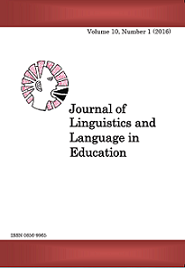The Phonetic Manifestation of -ile Suffix across Bantu Languages: The Case of Nyasa-Tanganyika Corridor
Abstract
This paper investigates the phonetic manifestation of -ile suffix across three
selected Bantu languages forming the Nyasa-Tanganyika corridor. The study is
guided by the Theory of Utterance selection whose underlying thesis vests on
the assumption that speakers subconsciously change linguistic forms towards
simplified ones. Data were collected from written texts, narrative stories and
interviews. The findings indicate that three phonetic forms of the suffix which
are -ite, -ile and -ie exist across these languages. In Ndali the suffix manifests
itself into -ite and -ile under varying conditions. It is also indicated that the
suffix acquires irregular phonetic shape as a result of its suffixation to
irregular verbs which are defined differently across the languages under
investigation.
References
Asheli, N. (2013). A Grammatical Sketch of Shinyiha. Dar es Salaam:
Languages of Tanzania Project.
Bastin, Y. (1983). La Finale Verbale-ô€€¬ô€€§ô€€¨ô€€ƒô€ˆô€—ô€€ƒô€ô€‚·ô€Œô€ô€…ô€•ô€Œô€†ô€„ô€—ô€Œô€’ô€‘ô€€ƒô€ˆô€‘ô€€ƒô€€¥ô€„ô€‘ô€—ô€’ô€˜.
Tervuren: MRAC.
Botne, R. (2003). Dissociation in Tense, Realis and Location in
Chindali Verbs. Anthropological Linguistics, 45(4): 290􀂲412.
Botne, R. (2010). Perfectives and Perfects and Past, oh my!: On the
Semantics of -ILE in Bantu. African Linguistica, 16 : 31􀂲64.
Bybee, J. L. & Dahl, Ó§. (1989). The Creation of Tense and Aspect
Systems in the Languages of the World. Studies in Language,
(1) : 51􀂲103.
Campbell, L. (2006). Historical Linguistics: An Introduction (2nd ed.).
Cambridge: MIT Press.
Croft, W. (2000). Explaining Language Change: An Evolutionary
Approach. London: Longman.
Harford, C. & Malambe, G. (2017). An Optimality Theoretic
Perspective on perfective imbrication in Siswati. Nordic
Journal of African Studies, 26(4): 277􀂲291.
Hayes, B. (2009). Introductory Phonology. Oxford: Wiley-Blackwell.
Hyman, L. M. (1995). Minimality and the Prosodic Morphology of
Cibemba Imbrication. Journal of African Languages &
Linguistics, 16(1): 3􀂲39.
| The Phonetic Manifestation of -ile Suffix across Bantu Languages
Hyman, L. M. (2007). Reconstruction of the Proto-Bantu Verb Unit:
Internal Evidence. SOAS Working Papers in Linguistics, 15:
􀂲211.
Kahigi, K. K. (1989). Development Affecting the Bantu Perfective in
*-ile: Another View. Journal of the Institute of Kiswahili
Research, 56, 92􀂲107.
Kotzé, A. E. (2004). A Diachronic Approach to the Explanation of
Problematic Past Tense Forms in Lobedu and Northern Sotho.
South African Journal of African Languages, 24 (1): 20􀂲35.
Kotzé, A. E. (2008). Making Sense of Irregular Realizations of the
Past Tense Suffix in Northern Sotho: The Phonology-
Morphology Interface. Southern African Linguistics and
Applied Language Studies, 26(2): 2017􀂲234.
Kula, N. C. (2001). Imbrication in Bemba. In Hume, E., N. Smith &
J. van de Weijer (eds.). Surface Syllable Structure and
Segmental Sequencing. HIL Occasional Papers: 102􀂲116.
Lusekelo, A. (2013). Tense, Aspect, Modality and Negation in
Nyakyusa : A Bantu Language of Tanzania and Malawi.
Germany: LAP.
Mazrui, A. M. (1983). Aspect Marking in Swahili: Accounting for
Variation. Journal of the Institute of Kiswahili Research,
(2): 18􀂲27.
Meeussen, A. E. (1967). Bantu Grammatical Reconstructions.
Africana Linguistica, 3: 79􀂲121.
Mkude, D. J. (1974). A Study of Kiluguru Syntax with Special
Reference to Transformational History of Sentences with
Permuted Subject and Object. Unpublished PhD Thesis.
University of London.
Mould, M. (1972). On Reconstruction of the Modified Base of Bantu
Verbs. Studies in African Linguistics, 3(1): 107􀂲125.
Morrison, M. (2012, March). Imbrication in Bena. Paper presented at
the annual conference in African Linguistics.
Mreta, A. Y. (1998). An Analysis of Tense and Aspect in Chasu: Their
Forms and Meaning in the Affirmative Constructions.
Hamberg: LIT.
Muzale, H. R .T. (1998). A Reconstruction of the Proto-Rutara Tense
-Aspect System. ô€€³ô€‹ô€€§ô€€ƒô€€·ô€‹ô€ˆô€–ô€Œô€–ô€€‘ô€€ƒô€€¶ô€—ô€€‘ô€€ƒô€€ô€’ô€‹ô€‘ô€‚·s Memorial University.
Nurse, D. & Philippson, G. (2006). Common Tense-Aspect Markers in
Bantu. Journal of African Language and Linguistics, 27(2):
􀂲196.
Nurse, D. (2008). Tense and Aspect in Bantu. Oxford: OUP.
Nichodamus Robinson | 89
Persohn, B. (2017). The Verb in Nyakyusa: A Focus on Tense, Aspect
and Modality (Contemporary African Linguistics 2). Berlin:
Language Science Press.
Robinson, N. (2015). The -ile Suffix and the Distinction between
Tense and Aspect in Nyakyusa. Unpublished MA
Dissertation, University of Dar es Salaam.
Rugemalira, J. M. (2005). A Grammar of Runyambo. Dar es Salaam:
Languages of Tanzania Project.
Swilla, I. N. (1998). Tenses in Chindali. Afrikanistische
Arbeitspapiere, 54: 95􀂲125
Downloads
Published
Issue
Section
License
Copyright © by Department of Foreign Languages and Linguistics, University of Dar es Salaam
All rights reserved. No part of this publication may be reproduced or transmitted in any form or by any means, electronic or mechanical, including photocopying, recording, or any information storage or retrieval system, without permission in writing from the publisher, except for short extracts in fair dealing, for research or private study, critical scholarly review or discourse with an acknowledgement.



